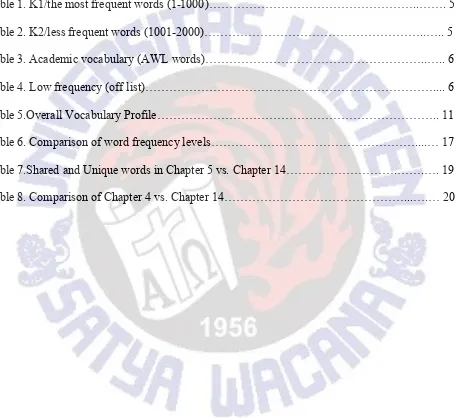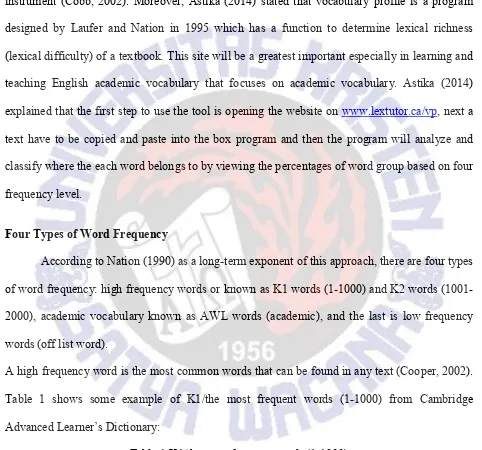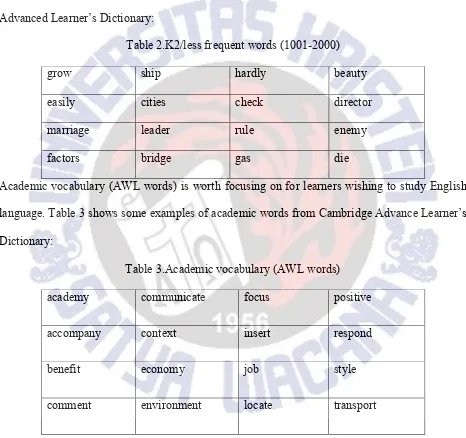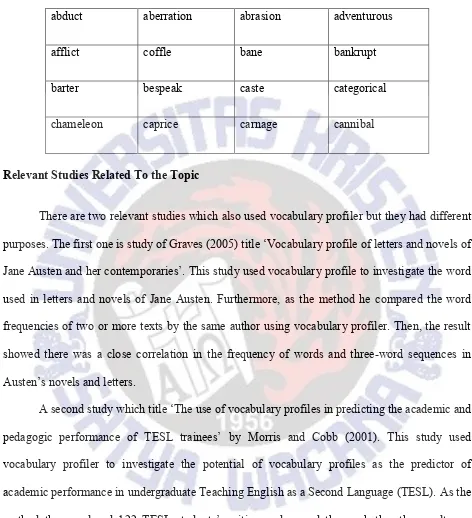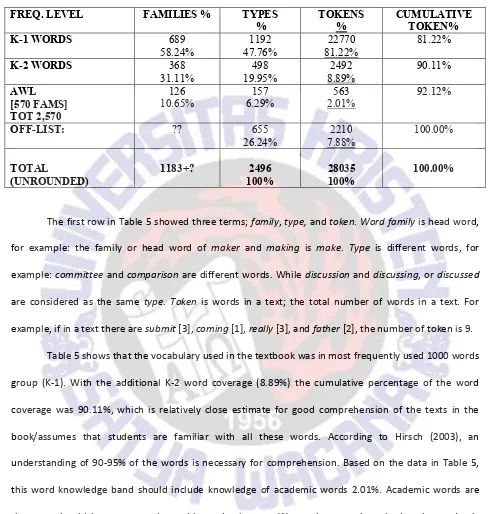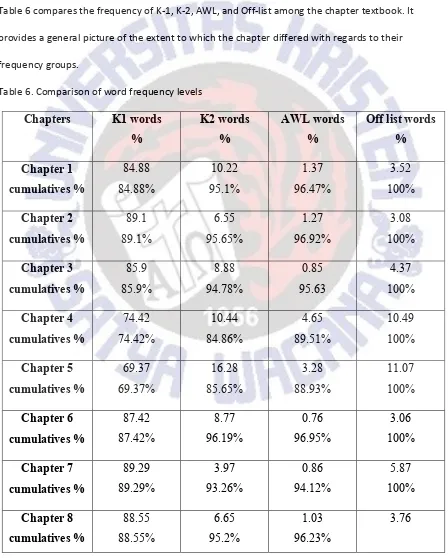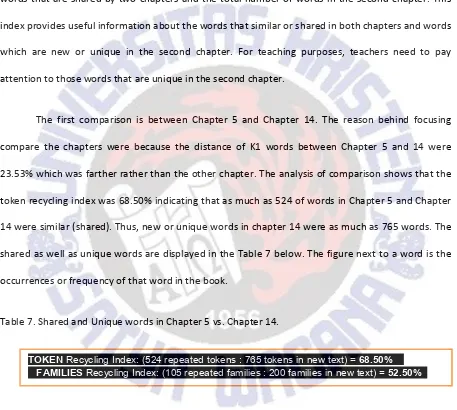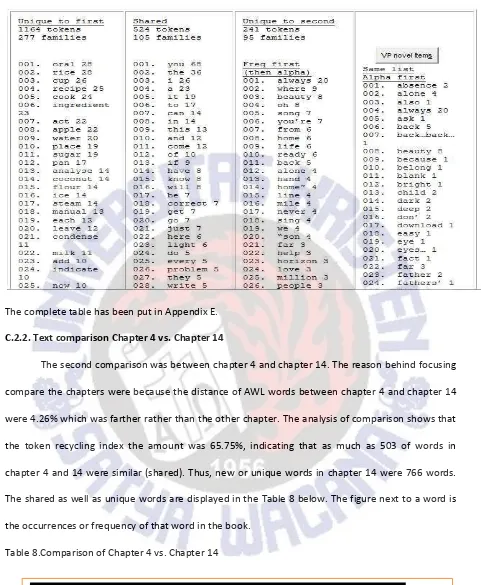10
VOCABULARY PROFILE OF THE NINTH GRADE ENGLISH
TEXTBOOK USED IN SMPN 7 SALATIGA
THESIS
Submitted in Partial Fulfilment
of the Requirements for the Degree of
Sarjana Pendidikan
Elis Herdiani Alfian
112012140
ENGLISH LANGUAGE EDUCATION PROGRAM
FACULTY OF LANGUAGE AND LITERATURE
SATYA WACANA CHRISTIAN UNIVERSITY
SALATIGA
18
TABLE OF CONTENT
COVER PAGE……… i
APPROVAL PAGE……….ii
COPYRIGHT STATEMENT……….iii
PUBLICATION AGREEMENT DECLARATION... iv
TABLE OF CONTENT………..v
LIST OF TABLE………..vii
ABSTRACT……… 1
INTRODUCTION……….. 1
LITERATURE REVIEW…..………. 3
The Importance of Vocabulary………... 3
How to Successfully Learn and Teach Vocabulary……….... 3
Problems in Learning Vocabulary………. 4
Vocabulary Profiler……… 4
Four Types of Word Frequency………. 5
Relevant Studies Related to the Topic………... 7
THE STUDY……….. 8
Context of the Study………... 8
Material………... 8
19
Data Collection Procedure……….. 9
Data Analysis Procedure……….… 9
FINDINGS AND DISCUSSION... 10
A. Overall Vocabulary Profile of the Textbook………..… 10
B. Negative vocabulary profiles of the textbook……….….12
C. Comparison of Vocabulary frequency levels every chapter in the textbook……….. 16
CONCLUSION………..………...… 21
REFERENCES..………...……….………. 23
ACKNOWLEDMENTS...……….……… 24
20
LIST OF TABLE
Table 1. K1/the most frequent words (1-1000)………..……. 5
Table 2. K2/less frequent words (1001-2000)………..….. 5
Table 3. Academic vocabulary (AWL words)………..….. 6
Table 4. Low frequency (off list)……….... 6
Table 5.Overall Vocabulary Profile……….. 11
Table 6. Comparison of word frequency levels………....… 17
Table 7.Shared and Unique words in Chapter 5 vs. Chapter 14……….…….…. 19
21
INTRODUCTION
Vocabulary is one of main elements to foreign language students’ understanding of what they read in books, what they hear from English teachers in school, and to communicate successfully with other people. In fact, it is important to build up a wide store of English words in a students’ brain since English become a lingua franca in the world. Kweldju and Priyono (2004, as cited in Widiati & Cahyono, 2008) stated that vocabulary is believed to be the most crucial element in a learning process. They also recommend a solution can be found by good handling and by choosing an appropriate vocabulary.
Sometimes English teacher may face difficulties in teaching vocabulary words because they do not notice or find suitable words from textbook to teach students. Students’ lack of vocabulary knowledge may prevent them for understanding textbook being used. With the continuous progress of the technology, there is a tool called vocabulary profiler. Vocabulary profiler is a tool to measure the vocabulary production from a text (Astika, 2014). Therefore, the English teacher can use the tool to describe and calculate the frequency of words used in a textbook and then decide in which groups each word belongs to.
The aim or objective of this research was to analyze vocabulary profile in English course textbook used in SMP N 7 Salatiga entitled ‘‘Think Globally Act Locally’ for grade IX. The book was published in 2014 by Kementrian Pendidikandan Kebudayaan Republik Indonesia.
22
chosen since as my experienced teaching PPL ninth grader students in SMPN 7 Salatiga, they find difficulties in learning process used that book, so I wanted to investigate the words frequency of the textbook.
It is important to find out because this research might be helpful for the teachers in Junior High School to know which part of vocabulary is proper for the beginner, intermediate, or advanced students. Also, teachers can teach vocabulary based on the arrangement of the word list whether it is include as academic words, low frequency words, or high frequency words depend on vocabulary profile’s result. However it also important to the writer’ publisher to improve their arrangement of beginner to academic vocabulary in their book became better than before.
Furthermore, the research questions that will be used to address the aim of this study are: 1. What is Vocabulary Profile of The Ninth Grade English Textbook used in SMPN 7 Salatiga? 2. What is the proportion of vocabulary that is not covered in the textbook?
3. What is the token (words) recycling index off the textbook?
LITERATURE REVIEW
The Importance of Vocabulary
23
an important part of language acquisition that have to be monitored and controlled not only in speaking skill and writing skill (productive) but also in listening skill and reading skill (receptive).
How to Successfully Learn and Teach English Vocabulary
In order to make learners successfully learn or teach English vocabulary, teachers have to use appropriate way to teach English in the class. Beck, McKeown, and Kucan (2002) recommended that teachers should choose academic words that appear in a broad variety of texts, provide student-friendly explanations for them, create instructional contexts that supply useful information about new words, and engage students in actively dealing with word meanings using academic words. However, the classification of four type word frequency especially academic words may useful for teacher and students in selecting the vocabulary that is needed and most relevant in learning.
Problems in Learning Vocabulary
24
Vocabulary Profiler
By a development of media in English learning there is a tool called vocabulary profiler. Vocabulary profiler itself is an on-line adaptation of Nation and Hwang’s vocabulary assessment instrument (Cobb, 2002). Moreover, Astika (2014) stated that vocabulary profile is a program designed by Laufer and Nation in 1995 which has a function to determine lexical richness (lexical difficulty) of a textbook. This site will be a greatest important especially in learning and teaching English academic vocabulary that focuses on academic vocabulary. Astika (2014) explained that the first step to use the tool is opening the website on www.lextutor.ca/vp, next a text have to be copied and paste into the box program and then the program will analyze and classify where the each word belongs to by viewing the percentages of word group based on four frequency level.
Four Types of Word Frequency
According to Nation (1990) as a long-term exponent of this approach, there are four types of word frequency: high frequency words or known as K1 words (1-1000) and K2 words (1001-2000), academic vocabulary known as AWL words (academic), and the last is low frequency words (off list word).
A high frequency word is the most common words that can be found in any text (Cooper, 2002). Table 1 shows some example of K1/the most frequent words (1-1000) from Cambridge Advanced Learner’s Dictionary:
Table 1.K1/the most frequent words (1-1000)
end are is to
25
that the for and
was our as of
Moreover, Table 2 shows some example of K2/less frequent words (1001-2000) from Cambridge Advanced Learner’s Dictionary:
Table 2.K2/less frequent words (1001-2000)
grow ship hardly beauty
easily cities check director
marriage leader rule enemy
factors bridge gas die
Academic vocabulary (AWL words) is worth focusing on for learners wishing to study English language. Table 3 shows some examples of academic words from Cambridge Advance Learner’s Dictionary:
Table 3.Academic vocabulary (AWL words) academy communicate focus positive
accompany context insert respond
benefit economy job style
comment environment locate transport
26
Table 4.Low frequency (off list)
abduct aberration abrasion adventurous
afflict coffle bane bankrupt
barter bespeak caste categorical
chameleon caprice carnage cannibal
Relevant Studies Related To the Topic
There are two relevant studies which also used vocabulary profiler but they had different purposes. The first one is study of Graves (2005) title ‘Vocabulary profile of letters and novels of Jane Austen and her contemporaries’. This study used vocabulary profile to investigate the word used in letters and novels of Jane Austen. Furthermore, as the method he compared the word frequencies of two or more texts by the same author using vocabulary profiler. Then, the result showed there was a close correlation in the frequency of words and three-word sequences in Austen’s novels and letters.
27
However vocabulary profile was proved became a useful tool in carrying out a standard to make an appropriate assessment of language skill.
The similarity between two researchers above is they used the same tool, vocabulary profiler. Moreover, the difference between them was in the context. Graves’s context was about the vocabulary profile on letters and novels. Moreover, Morris and Cobb’s context was about vocabulary profile on academic performance in undergraduate TESL. However, I used vocabulary profiler to analyse the vocabulary profiles in ninth grade’s book title ‘Think Globally Act Locally’ at SMPN 7 Salatiga since it has not been investigated using vocabulary profiler before.
THE STUDY
The study used descriptive method to study a textbook. According to Rivera and Rivera (2007) descriptive method is used to find facts that appear according on personal judgment or theories which also contains the description, recording, analysis, and interpretation. Therefore, this study used descriptive method to analyze types of vocabularies from a textbook, vocabulary that were not covered, and token word recycling index by using vocabulary profiler.
Context of the Study
28
Material
The study focused on ninth graders book entitled ‘Think Globally Act Locally’ which contains fourteen chapters. All chapters inside the book are used to find out in which group each vocabularies belongs to, vocabulary that were not covered, and token word recycling index. The study used ninth graders’ book as a material because ninth grader soon will do final examination to continue their study to Senior High School. Therefore, they had to prepare more and enrich their vocabulary English to strengthen their preparation before final examination.
Data Collection Instruments
The study used vocabulary profiler as a tool. This tool can be accessed through www.lextutor.ca.vp. One of its functions is to check vocabulary profile used in a textbook. The result can be shown in different striking color; blue for high frequency words, yellow for academic words, and red for low frequency words.
Data Collection Procedure
To collect the data, all words from the e-book materials have to be copied from e-book into Microsoft Word first to make it easier and practical before the words being moved to box in Vocabulary Profiler. Every chapter would be copied in different Microsoft Word file, so that the total was fourteen Microsoft Word files.
Data Analysis Procedure
29
30
FINDINGS AND DISCUSSION
This study showed the identification of vocabulary profile of Think Globally Act Locally book for grade IX. Vocabulary profiler was used to calculate and analyze every word in chapter 1 until 14 which total 40.621 words. Furthermore, the finding was separated in three big parts. The first part of this section presented the overall vocabulary profile of the textbook showing the proportions of the vocabulary frequency classifications. The second part showed the negative vocabulary profiles of 1, K-2, and AWL with lists of the vocabulary items that were not found in the textbook, also block frequency output of off-list words. The last part of this section showed the comparison of the chapter in the textbook with regard to the vocabulary items that were contrast. The comparison also showed the token recycling index that provided information about an estimate of chapter comprehensibility.
Here, before the words being analyzed some words were eliminated to reduce the result of off list words such as number, name, to be (am, is, are, was, and were), Indonesian words, name of city, and name of country. Therefore, the spelling mistakes were also corrected.
D. Overall Vocabulary Profile of the Textbook
31 Table 5. Overall Vocabulary Profile
FREQ. LEVEL FAMILIES % TYPES %
TOKENS %
CUMULATIVE TOKEN%
K-1 WORDS 689
58.24%
1192 47.76%
22770 81.22%
81.22%
K-2 WORDS 368
31.11%
498 19.95%
2492 8.89%
90.11%
AWL [570 FAMS] TOT 2,570
126 10.65%
157 6.29%
563 2.01%
92.12%
OFF-LIST: ?? 655
26.24%
2210 7.88%
100.00%
TOTAL
(UNROUNDED)
1183+? 2496 100%
28035 100%
100.00%
The first row in Table 5 showed three terms; family, type, and token. Word family is head word, for example: the family or head word of maker and making is make. Type is different words, for example: committee and comparison are different words. While discussion and discussing, or discussed are considered as the same type. Token is words in a text; the total number of words in a text. For example, if in a text there are submit [3], coming [1], really [3], and father [2], the number of token is 9.
32
(low frequency words), it may have words that students at this level need to know. This low frequency list should not be ignored in teaching and teachers have to make a selection for useful words in this category.
E. Negative vocabulary profiles of the textbook
This section presents the description of negative vocabulary profiles of the sample textbook. Negative vocabulary is vocabulary items that are not found in the textbook. These missing words are derived from differences of words in the New General Word List (NGWL) and words in the textbook used in this study. The list of negative K-1 words below is useful for teachers in selecting vocabulary items that students may find useful to develop their vocabulary knowledge.
B.1. Negative VP of K-1
This following analysis shows all the word families (=head words) from the K-1 level that were not found in the textbook. The summary of negative vocabulary profile for K-1 level is presented below:
K-1 Total word families: 964
K-1 families in input: 679 (70.44%)
K-1 families not in input: 286 (29.67%)
These percentages do not refer to tokens or number of words in the textbook but rather number of word families. According to the summary, 70.44% of word families were found in the textbook, which means, 29.67% of ord fa ilies ere issi g or ot fou d ased o the ords listed in New General Service List (NGSL). The followings are 10% of the word families that are not found in the input textbook. The complete word list has been put in Appendix A ACCOUNT
ACCOUNTABLE ACROSS ACTOR ACTRESS
ADMIT ADVANCE ADVANTAGE
ADVENTURE AFFAIR
AGAINST AGE ALLOW ALONG ANCIENT APPEAR
33 ATTACK ATTEMPT
AVERAGE BALL
BAR BATTLE, etc
B.2. Negative VP of K-2
This analysis shows all the word families (=head words) from the K-2 level that were not found in the input textbook. The summary of negative vocabulary profile for K-2 level is presented below:
K-2 Total word families: 986
K-2 families in input: 367 (37.22%)
K-2 families not in input: 620 (62.88%)
These percentages do not refer to tokens or number of words in the textbook but rather number of word families. According to the summary, 37.22% of word families were found in the textbook, which means, 62.88% of ord fa ilies ere issi g or ot fou d ased o the ords listed in New General Service List (NGSL). The followings are 10% of the word families (K-2) that were not found in the input textbook. The complete word list has been put in Appendix B
ABROAD ABSENT ABSOLUTE ABSOLUTELY ACCUSE ACCUSTOM ADMIRE AEROPLANE AFFORD AGRICULTURE AIM AIRPLANE ALIKE ALIVE ALOUD ALTOGETHER
AMBITION AMUSE ANGLE ANXIETY APART APOLOGIZE APOLOGY APPLAUD APPROVE ARCH ARRANGE ARREST ARROW ASH ASHAMED ASIDE
ASTONISH AUTUMN AVENUE AWAKE AWKWARD AXE BAGGAGE BALANCE BAND BARBER BARE BARELY BARGAIN BARREL BASIN BATHE
BAY BEAK BEAM BEARD BEAST BEAT BEHAVE
34 B.3. Negative VP of AWL
This analysis shows all the word families (=head words) from the AWL level that were not found in the input textbook. The summary of negative vocabulary profile for AWL level is presented below:
AWL Total word families: 569
AWL families in input: 132 (23.20%)
AWL families not in input: 438 (76.98%)
These percentages do not refer to tokens or number of words in the textbook but rather number of word families. According to the summary, 23.20% of word families were found in the te t ook, hi h ea s, . % of ord fa ilies ere issi g or ot fou d ased o the ords listed
in New General Service List (NGSL). The followings are 10% of the word families that were not found in the textbook. The complete word list has been put in Appendix C.
ABSTRACT ACADEMY ACCESS
ACCOMMODATE
ACCUMULATE ACCURATEACK NOWLEDGE
ACQUIRE ADEQUATE ADJACENT ADMINISTRATE ADVOCATE
AFFECT AGGREGATE AID
ALBEIT ALLOCATE ALTER
ALTERNATIVE AMBIGUOUS AMEND ANALOGY ANNUAL ANTICIPATE
APPARENT APPEND APPRECIATE APPROXIMATE ARBITRARY ASPECT ASSEMBLE ASSESS ASSIGN ASSIST ASSUME ASSURE
25 B.4. Block frequency output of off-list words.
Description of block frequency output of off-list words in the textbook will be presented here. Using the tool in the Vocabulary Profiler, these words have been frequency-blocked per ten words and have been arranged from high to low frequency. This list of words may provide teachers with useful information as to what words are necessary for teaching. In other words, teachers may select words from the list that are relevant to teaching students at Junior High Schools. Below is the list of Off-list ords, ith 4 tokens and 543 types. Note that RANK is ranking of word, FREQ is
frequency of word occurrence, COVERAGE is the percentage of word occurrences, individual or cumulative, and the last column is the vocabulary item. The complete list of blocked frequency has been put in Appendix D.
RANK FREQ COVERAGE
individu cumulative
WORD
1. 66 3.87% 3.87% PUNCTUATION 2. 37 2.17% 6.04% ORALLY 3. 36 2.11% 8.15% BUFFALO 4. 28 1.64% 9.79% ORPHAN 5. 26 1.53% 11.32% INGREDIENTS 6. 23 1.35% 12.67% DRUG
7. 21 1.23% 13.90% ORPHANAGE 8. 20 1.17% 15.07% DIALOGUE 9. 19 1.12% 16.19% MAGAZINE 10. 19 1.12% 17.31% RECIPE 11. 18 1.06% 18.37% BATS
12. 16 0.94% 19.31% HOMEWORK 13. 16 0.94% 20.25% SERA
26 19. 13 0.76% 25.29% FABRICS
20. 13 0.76% 26.05% HANDWRITE
C. Comparison of Vocabulary frequency levels every chapter in the textbook
C.1. Comparison of Vocabulary frequency levels in every chapter
Table 6 compares the frequency of K-1, K-2, AWL, and Off-list among the chapter textbook. It provides a general picture of the extent to which the chapter differed with regards to their frequency groups.
Table 6. Comparison of word frequency levels
Chapters K1 words %
K2 words %
AWL words %
27 among the chapters were not very significant. In other words, the proportion of vocabulary items in each chapter was relatively similar. Contrast precentage was seen in the result of K-1 chapter 4, 5, 11, 12, and 13 which have lower (close to 80%) presentage rather than the other chapters. One more contrast percentage was in the AWL result on chapter 4, 5, 11, 12, and 13 which got result close to 90%. That was happened because total words in the textbook in chapter 4, 5, 11, 12, and 13 were lower rather than the other chapters which have higher total words.
28 C.2. Text comparison of the textbook:
C.2.1. Text comparison Chapter 5 vs. Chapter 14
This section presents the comparison of text between two chapters. The comparison shows the token recycling index of the chapters being compared. Recycling index is the ratio between words that are shared by two chapters and the total number of words in the second chapter. This index provides useful information about the words that similar or shared in both chapters and words which are new or unique in the second chapter. For teaching purposes, teachers need to pay attention to those words that are unique in the second chapter.
The first comparison is between Chapter 5 and Chapter 14. The reason behind focusing compare the chapters were because the distance of K1 words between Chapter 5 and 14 were 23.53% which was farther rather than the other chapter. The analysis of comparison shows that the token recycling index was 68.50% indicating that as much as 524 of words in Chapter 5 and Chapter 14 were similar (shared). Thus, new or unique words in chapter 14 were as much as 765 words. The shared as well as unique words are displayed in the Table 7 below. The figure next to a word is the occurrences or frequency of that word in the book.
Table 7. Shared and Unique words in Chapter 5 vs. Chapter 14.
TOKEN Recycling Index: (524 repeated tokens : 765 tokens in new text) = 68.50%
29 The complete table has been put in Appendix E. C.2.2. Text comparison Chapter 4 vs. Chapter 14
The second comparison was between chapter 4 and chapter 14. The reason behind focusing compare the chapters were because the distance of AWL words between chapter 4 and chapter 14 were 4.26% which was farther rather than the other chapter. The analysis of comparison shows that the token recycling index the amount was 65.75%, indicating that as much as 503 of words in chapter 4 and 14 were similar (shared). Thus, new or unique words in chapter 14 were 766 words. The shared as well as unique words are displayed in the Table 8 below. The figure next to a word is the occurrences or frequency of that word in the book.
Table 8.Comparison of Chapter 4 vs. Chapter 14
TOKEN Recycling Index: (503 repeated tokens : 765 tokens in new text) = 65.75%
30 The complete table has been put in Appendix F. CONCLUSION
The findings have presented identification of vocabulary profile from Act Locally Think Globally’ book. The study disclosed three results of what is vocabulary profile of the ninth grade Englsh textbook, what is the proportion of vocabulary that is not covered in the textbook, and what is the token (words) recycling index of the textbook. The result of overall vocabulary profile in the textbook showed the proportions of the vocabulary frequency classifications. For K-1 words (1-1000) was as much as 81.22%, K2 words (1001-2000) was as much as 8.89%, AWL words was as much as 2.01%, and the amount of Off List words was 7.88%.
31
families 569 words, which 132 words were not in input. The last but not least there were 1704 tokens words and 543 types of Off-list words.
The last result disclosed vocabulary frequency levels every chapter and two comparison of chapters which was contrast. For chapter 5 and chapter 14 which focus on K-1 contrast revealed that there was 68.50% token recycling index, 524 words were similar, and 765 new words were found in the chapter 14. Followed by comparison of chapter 4 and 14 which focus on AWL contrast revealed there was 65.75% token recycling index, 503 words were similar, and 766 new words were found in the chapter 14.
32
REFERENCES
Astika, G. (2014). Profiling the vocabulary of news texts as capacity for language teachers. Indonesian Journal of Applied Linguistics,4 (2), 257-266.
Bardel, C & Lindqvist, C. (2011). Developing a lexical profiler for spoken French L2 and Italian L2. John Benjamins Publishing Company. Stockholm University / Uppsala University.
Cahyono & Widiati (2008). The teaching of EFL vocabulary in the Indonesian context. Indonesian Journal of Applied Linguistics.
Chung, T, M, & Nation, P. (2004). Identifying technical vocabulary school of linguistics and applied language studies. Victoria University, 32, 251–263.
Cobb, T. (2010). Learning about language and learner from computer programs. Reading in a Foreign Language, 22.
Graves, D. (2005).Vocabulary profiles of letters and novels of Jane Austen and her contemporaries. Jane Austen Society of North America, 26 (1).
I.S.P. Nation. (1990). Teaching and learning vocabulary. Victoria : Victoria University Wellington. Morris, L, & Cobb, T. (2004).Vocabulary profiles as predictors of the academic performance of
teaching English as a second language trainees: System 32, 75-78.
Nation, I. S. P. (2002). Best practice in vocabulary teaching and learning.In Richards, J. C. & Renandya, W. A. (Eds.), Methodology in Language teaching: An Anthology of Current Practice (pp. 258-266). Cambridge: Cambridge University Press.
Nobert & Diane, S. (2012). Plenary speech a reassessment of frequency and vocabulary size in L2 vocabulary teaching, Cambridge: Cambridge University Press.
Rivera, M. & Rivera, R. (2007). Practical guide to thesis and dissertation writing. Quezon City: KATHA Publishing, Inc.
Schmitt, N. (2000). Vocabulary in language teaching.Cambridge : Cambridge University Press.
33
ACKNOWLEDGEMENT
This study cannot be completed without many supports and helps. First, I would like to thank to Allah SWT for giving me spirit and strength to finish this study. I would like to express my sincere gratitude to my supervisor, Anne Indrayanti Timotius, M.Ed. for her invaluable patience and guidance during the completion of this study, and also my examiner, Prof. Dr. Gusti Astika, M.A for his guidance for this thesis. I also would like to say thank you for teachers in SMPN 7 Salatiga who guiding and giving me advice related to this study.
34
Append
i
x A
35
38
Append
i
x
C
40
Appendix D
Block frequency output of off-list words.
RANK FREQ COVERAGE
individ cumulative WORD
1. 66 3.87% 3.87% PUNCTUATION 2. 37 2.17% 6.04% ORALLY
3. 36 2.11% 8.15% BUFFALO 4. 28 1.64% 9.79% ORPHAN 5. 26 1.53% 11.32% INGREDIENTS 6. 23 1.35% 12.67% DRUG
7. 21 1.23% 13.90% ORPHANAGE 8. 20 1.17% 15.07% DIALOGUE 9. 19 1.12% 16.19% MAGAZINE 10. 19 1.12% 17.31% RECIPE 11. 18 1.06% 18.37% BATS
12. 16 0.94% 19.31% HOMEWORK 13. 16 0.94% 20.25% SERA
14. 15 0.88% 21.13% CLASSROOM 15. 15 0.88% 22.01% COCONUT 16. 15 0.88% 22.89% NOVEL 17. 15 0.88% 23.77% UNDERLINE 18. 13 0.76% 24.53% ENCYCLOPEDIA 19. 13 0.76% 25.29% FABRICS
20. 13 0.76% 26.05% HANDWRITE 21. 12 0.70% 26.75% EXPIRATION 22. 12 0.70% 27.45% ORAL
41 24. 11 0.65% 28.75% BANANA 25. 11 0.65% 29.40% COLUMN 26. 11 0.65% 30.05% CONDENSED 27. 11 0.65% 30.70% MAMMALS 28. 11 0.65% 31.35% RAVEN 29. 10 0.59% 31.94% DIARRHEA 30. 10 0.59% 32.53% DOSAGE 31. 10 0.59% 33.12% KIDS 32. 10 0.59% 33.71% SWITCH 33. 9 0.53% 34.24% CELEBRATE 34. 9 0.53% 34.77% COCKTAIL 35. 9 0.53% 35.30% FOLKTALE 36. 9 0.53% 35.83% PM
37. 8 0.47% 36.30% AFRICAN 38. 8 0.47% 36.77% CANTEEN 39. 8 0.47% 37.24% CLUES 40. 8 0.47% 37.71% FOXES 41. 8 0.47% 38.18% MATH 42. 8 0.47% 38.65% PUDDING 43. 8 0.47% 39.12% SYRUP
44. 7 0.41% 39.53% INGREDIENT 45. 7 0.41% 39.94% MOTORCYCLE 46. 7 0.41% 40.35% OLIVE
47. 7 0.41% 40.76% PLASTIC 48. 7 0.41% 41.17% RECIPES 49. 7 0.41% 41.58% TRAFFIC 50. 7 0.41% 41.99% VEGETABLES 51. 6 0.35% 42.34% BAT
52. 6 0.35% 42.69% DOUGH
53. 6 0.35% 43.04% HANDICRAFTS 54. 6 0.35% 43.39% HORNS
42 56. 6 0.35% 44.09% MESSY
57. 6 0.35% 44.44% PEDESTRIANS 58. 6 0.35% 44.79% SLICED
59. 6 0.35% 45.14% TRASH 60. 5 0.29% 45.43% ATTICS 61. 5 0.29% 45.72% AWARD 62. 5 0.29% 46.01% BADMINTON 63. 5 0.29% 46.30% BATHROOM 64. 5 0.29% 46.59% BEEF
65. 5 0.29% 46.88% BLANK 66. 5 0.29% 47.17% FABRIC 67. 5 0.29% 47.46% FIBERS 68. 5 0.29% 47.75% GOODS 69. 5 0.29% 48.04% GREEK 70. 5 0.29% 48.33% HOBBY
71. 5 0.29% 48.62% HOUSEWORK 72. 5 0.29% 48.91% JAVA
73. 5 0.29% 49.20% NOVELS 74. 5 0.29% 49.49% OREGANO 75. 5 0.29% 49.78% SPECIES 76. 5 0.29% 50.07% SUNSET 77. 4 0.23% 50.30% ABSORBENT 78. 4 0.23% 50.53% AMAZING 79. 4 0.23% 50.76% AUSTRALIA 80. 4 0.23% 50.99% CHARITY 81. 4 0.23% 51.22% CHOIR
82. 4 0.23% 51.45% CONJUNCTION 83. 4 0.23% 51.68% CRYSTALS 84. 4 0.23% 51.91% DAMSELFLY 85. 4 0.23% 52.14% DECORATION 86. 4 0.23% 52.37% DIGEST
43 88. 4 0.23% 52.83% ETC
89. 4 0.23% 53.06% FIBER
90. 4 0.23% 53.29% FINGERTIPS 91. 4 0.23% 53.52% HANDICRAFT 92. 4 0.23% 53.75% HAPPENINGS 93. 4 0.23% 53.98% HEATPROOF 94. 4 0.23% 54.21% HERDS 95. 4 0.23% 54.44% INDONESIA 96. 4 0.23% 54.67% JAMS
97. 4 0.23% 54.90% LAMB
98. 4 0.23% 55.13% LENGTHWISE 99. 4 0.23% 55.36% LUMPY
44 120. 4 0.23% 60.19% THERMAL 121. 4 0.23% 60.42% TOFU 122. 4 0.23% 60.65% TV
123. 4 0.23% 60.88% VEGETABLE 124. 4 0.23% 61.11% WALLOW 125. 4 0.23% 61.34% WATERPROOF 126. 4 0.23% 61.57% WETTER 127. 3 0.18% 61.75% ACROBATIC 128. 3 0.18% 61.93% AFRICA 129. 3 0.18% 62.11% ALCOHOL 130. 3 0.18% 62.29% ASPIRIN 131. 3 0.18% 62.47% AWESOME 132. 3 0.18% 62.65% BAMBOO 133. 3 0.18% 62.83% BANANAS 134. 3 0.18% 63.01% BIKE 135. 3 0.18% 63.19% BOUNCE 136. 3 0.18% 63.37% BRACKETS 137. 3 0.18% 63.55% CERAMICS 138. 3 0.18% 63.73% CHASE 139. 3 0.18% 63.91% CHORES 140. 3 0.18% 64.09% CM
141. 3 0.18% 64.27% COVERINGS 142. 3 0.18% 64.45% DICTATE 143. 3 0.18% 64.63% DONNY 144. 3 0.18% 64.81% DOWNLOAD 145. 3 0.18% 64.99% EARPHONES 146. 3 0.18% 65.17% ECHOES 147. 3 0.18% 65.35% FURRY 148. 3 0.18% 65.53% GARLIC
149. 3 0.18% 65.71% GRASSHOPPERS 150. 3 0.18% 65.89% GRILL
45 152. 3 0.18% 66.25% GUITAR 153. 3 0.18% 66.43% HABITAT 154. 3 0.18% 66.61% HENS 155. 3 0.18% 66.79% INFO 156. 3 0.18% 66.97% JUNIOR 157. 3 0.18% 67.15% MAYOR
158. 3 0.18% 67.33% MEANINGFULLY 159. 3 0.18% 67.51% METER
160. 3 0.18% 67.69% ML 161. 3 0.18% 67.87% MOP
162. 3 0.18% 68.05% MOSQUITOES 163. 3 0.18% 68.23% MUSCLES 164. 3 0.18% 68.41% NOCTURNAL 165. 3 0.18% 68.59% NUTRITION 166. 3 0.18% 68.77% ORPHANS 167. 3 0.18% 68.95% OVERDOSE 168. 3 0.18% 69.13% OXYGEN 169. 3 0.18% 69.31% PALM 170. 3 0.18% 69.49% PITCHED 171. 3 0.18% 69.67% PLUG 172. 3 0.18% 69.85% POLLEN 173. 3 0.18% 70.03% POLLUTION 174. 3 0.18% 70.21% PREY
46 184. 3 0.18% 72.01% SQUEALS 185. 3 0.18% 72.19% SYRUPY
186. 3 0.18% 72.37% TEASPOONFUL 187. 3 0.18% 72.55% TROPICAL 188. 3 0.18% 72.73% UNPLUG 189. 3 0.18% 72.91% YOUTUBE
190. 2 0.12% 73.03% ACETAMINOPHEN 191. 2 0.12% 73.15% AVOCADO
192. 2 0.12% 73.27% BACTERIA 193. 2 0.12% 73.39% BARLEY 194. 2 0.12% 73.51% BATIK 195. 2 0.12% 73.63% BEACH 196. 2 0.12% 73.75% BENNY 197. 2 0.12% 73.87% BIN 198. 2 0.12% 73.99% BINS 199. 2 0.12% 74.11% BOSS
200. 2 0.12% 74.23% BOYFRIEND 201. 2 0.12% 74.35% BUBBLING 202. 2 0.12% 74.47% CAMPUS 203. 2 0.12% 74.59% CARVING 204. 2 0.12% 74.71% CASUAL 205. 2 0.12% 74.83% CELSIUS 206. 2 0.12% 74.95% CHILLY 207. 2 0.12% 75.07% CHOCOLATE 208. 2 0.12% 75.19% CLASSMATES 209. 2 0.12% 75.31% COACH
47 216. 2 0.12% 76.15% CROW 217. 2 0.12% 76.27% CUBED 218. 2 0.12% 76.39% CUBES 219. 2 0.12% 76.51% DISSOLVES 220. 2 0.12% 76.63% DONATED 221. 2 0.12% 76.75% DRAGONFLIES 222. 2 0.12% 76.87% DRUGS
223. 2 0.12% 76.99% DUSTY 224. 2 0.12% 77.11% EBONY 225. 2 0.12% 77.23% ELDEST 226. 2 0.12% 77.35% EMAIL
227. 2 0.12% 77.47% ENCYCLOPEDIAS 228. 2 0.12% 77.59% ENTITLED
229. 2 0.12% 77.71% FOREHEAD 230. 2 0.12% 77.83% GARBAGE 231. 2 0.12% 77.95% GEMS 232. 2 0.12% 78.07% GENIES 233. 2 0.12% 78.19% GILLS
234. 2 0.12% 78.31% GRADUATION 235. 2 0.12% 78.43% GRASSHOPPER 236. 2 0.12% 78.55% GRATED
237. 2 0.12% 78.67% GUAVA 238. 2 0.12% 78.79% HABITATS 239. 2 0.12% 78.91% IMPERATIVE 240. 2 0.12% 79.03% INSULATORS 241. 2 0.12% 79.15% IRREFUTABLE 242. 2 0.12% 79.27% JACKFRUIT 243. 2 0.12% 79.39% JOG
48 248. 2 0.12% 79.99% MOTORCYCLES 249. 2 0.12% 80.11% MULLET
250. 2 0.12% 80.23% MUSCLE 251. 2 0.12% 80.35% NON 252. 2 0.12% 80.47% NOODLE 253. 2 0.12% 80.59% NYMPHS
254. 2 0.12% 80.71% OHH&#NUMBER;OHH&#NUMBER;OHH 255. 2 0.12% 80.83% ORES
256. 2 0.12% 80.95% PANTS 257. 2 0.12% 81.07% PASTRY 258. 2 0.12% 81.19% PAVEMENTS 259. 2 0.12% 81.31% PEEL
260. 2 0.12% 81.43% PHYSICIAN 261. 2 0.12% 81.55% PILLOWS 262. 2 0.12% 81.67% PLASTICS 263. 2 0.12% 81.79% POLLUTED 264. 2 0.12% 81.91% PRACTICED 265. 2 0.12% 82.03% PREDATOR 266. 2 0.12% 82.15% PRESERVATIVES 267. 2 0.12% 82.27% PUPPETEER 268. 2 0.12% 82.39% PUPPETS 269. 2 0.12% 82.51% REWRITE 270. 2 0.12% 82.63% ROUTINELY 271. 2 0.12% 82.75% SANDSTONE 272. 2 0.12% 82.87% SAUCEPAN 273. 2 0.12% 82.99% SCAVENGER 274. 2 0.12% 83.11% SENSATION 275. 2 0.12% 83.23% SENSATIONAL 276. 2 0.12% 83.35% SHRED
49 280. 2 0.12% 83.83% SOAKS 281. 2 0.12% 83.95% SOY
282. 2 0.12% 84.07% SQUASHED 283. 2 0.12% 84.19% SUNDRIED 284. 2 0.12% 84.31% SWEETHEART 285. 2 0.12% 84.43% TAMARIND 286. 2 0.12% 84.55% TEAK 287. 2 0.12% 84.67% TEASPOON 288. 2 0.12% 84.79% TELESCOPE 289. 2 0.12% 84.91% TINY
290. 2 0.12% 85.03% TISSUES 291. 2 0.12% 85.15% TUB 292. 2 0.12% 85.27% VENDOR 293. 2 0.12% 85.39% WEDDING 294. 2 0.12% 85.51% WEDDINGS 295. 2 0.12% 85.63% WOVEN 296. 2 0.12% 85.75% WOW 297. 1 0.06% 85.81% ABSORB 298. 1 0.06% 85.87% ABSORBS 299. 1 0.06% 85.93% ACEH 300. 1 0.06% 85.99% ACHIEVER 301. 1 0.06% 86.05% ACID
302. 1 0.06% 86.11% ADDITIVES 303. 1 0.06% 86.17% AHMAD 304. 1 0.06% 86.23% AIRLESS 305. 1 0.06% 86.29% AMBON 306. 1 0.06% 86.35% AMERICA 307. 1 0.06% 86.41% ANIDAN 308. 1 0.06% 86.47% ANT
50 312. 1 0.06% 86.71% ARABIC 313. 1 0.06% 86.77% ASCORBIC 314. 1 0.06% 86.83% AVAIBALE
315. 1 0.06% 86.89% BACK&#NUMBER;BACK 316. 1 0.06% 86.95% BAKERY
317. 1 0.06% 87.01% BALSA 318. 1 0.06% 87.07% BARBEQUE 319. 1 0.06% 87.13% BENCH
320. 1 0.06% 87.19% BLACKBOARD 321. 1 0.06% 87.25% BLENDED 322. 1 0.06% 87.31% BRAND 323. 1 0.06% 87.37% BRANDS 324. 1 0.06% 87.43% BROADWAY 325. 1 0.06% 87.49% BULL
326. 1 0.06% 87.55% BULLS 327. 1 0.06% 87.61% BUMP 328. 1 0.06% 87.67% CAFFEINE 329. 1 0.06% 87.73% CALENDAR 330. 1 0.06% 87.79% CARBOHYDRATE 331. 1 0.06% 87.85% CARVERS
332. 1 0.06% 87.91% CARVINGS 333. 1 0.06% 87.97% CASSAVA 334. 1 0.06% 88.03% CASTER
335. 1 0.06% 88.09% CELEBRATION 336. 1 0.06% 88.15% CELEBRATIONS 337. 1 0.06% 88.21% CELL
51 344. 1 0.06% 88.63% CIGAR
345. 1 0.06% 88.69% CIGARETTES 346. 1 0.06% 88.75% CLOVES 347. 1 0.06% 88.81% COCKROACH 348. 1 0.06% 88.87% COCKS
349. 1 0.06% 88.93% COCONUTS
350. 1 0.06% 88.99% COMMEMORATION 351. 1 0.06% 89.05% COMPULSORY 352. 1 0.06% 89.11% CONDITIONER 353. 1 0.06% 89.17% CONGRATULATION 354. 1 0.06% 89.23% CORIANDER
355. 1 0.06% 89.29% CRESTS 356. 1 0.06% 89.35% CUISINE 357. 1 0.06% 89.41% CURRICULAR 358. 1 0.06% 89.47% DAIRY
359. 1 0.06% 89.53% DAMSELFLIES 360. 1 0.06% 89.59% DAWN
361. 1 0.06% 89.65% DAYBREAK 362. 1 0.06% 89.71% DAYDREAM 363. 1 0.06% 89.77% DEHYDRATED 364. 1 0.06% 89.83% DESEEDED 365. 1 0.06% 89.89% DESSERT 366. 1 0.06% 89.95% DISCOUNT 367. 1 0.06% 90.01% DOLL 368. 1 0.06% 90.07% DONORS 369. 1 0.06% 90.13% DOSAGES 370. 1 0.06% 90.19% DOSE 371. 1 0.06% 90.25% DOSES
372. 1 0.06% 90.31% DRAGONFLY 373. 1 0.06% 90.37% DRAIN
52 376. 1 0.06% 90.55% EFFICIENTLY 377. 1 0.06% 90.61% ELEVATOR 378. 1 0.06% 90.67% EMBROIDERED 379. 1 0.06% 90.73% EMULSIFIER 380. 1 0.06% 90.79% ENT
381. 1 0.06% 90.85% ETERNAL 382. 1 0.06% 90.91% EVAPORATED 383. 1 0.06% 90.97% EXAM
384. 1 0.06% 91.03% EXEMPLARY
385. 1 0.06% 91.09% EXTRACURRICULAR 386. 1 0.06% 91.15% FARMYARD
387. 1 0.06% 91.21% FAUNA 388. 1 0.06% 91.27% FERMENTED 389. 1 0.06% 91.33% FINS
390. 1 0.06% 91.39% FLAMMABLE 391. 1 0.06% 91.45% FLIED
392. 1 0.06% 91.51% FLORA 393. 1 0.06% 91.57% FLU
394. 1 0.06% 91.63% FLUTTERING 395. 1 0.06% 91.69% FOSSILS 396. 1 0.06% 91.75% FOURTY 397. 1 0.06% 91.81% FRESHWATER 398. 1 0.06% 91.87% FULFILLED 399. 1 0.06% 91.93% GAEA 400. 1 0.06% 91.99% GEAE
53 408. 1 0.06% 92.47% GUYS
409. 1 0.06% 92.53% HANDSOME 410. 1 0.06% 92.59% HATCH 411. 1 0.06% 92.65% HEADACHE 412. 1 0.06% 92.71% HEADMASTER 413. 1 0.06% 92.77% HEARTED 414. 1 0.06% 92.83% HOP 415. 1 0.06% 92.89% HORN 416. 1 0.06% 92.95% IDR
417. 1 0.06% 93.01% IMPORTED 418. 1 0.06% 93.07% INACTIVE 419. 1 0.06% 93.13% INSISTED
420. 1 0.06% 93.19% INTERPERSONAL 421. 1 0.06% 93.25% JAKARTA
422. 1 0.06% 93.31% JAPANESE 423. 1 0.06% 93.37% JOGGING 424. 1 0.06% 93.43% KAPOK 425. 1 0.06% 93.49% KID
54 440. 1 0.06% 94.39% MANGOES 441. 1 0.06% 94.45% MATES 442. 1 0.06% 94.51% MILLILITERS 443. 1 0.06% 94.57% MODAL
444. 1 0.06% 94.63% MOISTURIZED 445. 1 0.06% 94.69% MOPPING 446. 1 0.06% 94.75% MOUNT 447. 1 0.06% 94.81% MSG 448. 1 0.06% 94.87% NETT
449. 1 0.06% 94.93% NONLIVING 450. 1 0.06% 94.99% NOTEBOOK 451. 1 0.06% 95.05% OAK
452. 1 0.06% 95.11% OATMEAL 453. 1 0.06% 95.17% ODER 454. 1 0.06% 95.23% OKAY 455. 1 0.06% 95.29% OLIVES 456. 1 0.06% 95.35% OPTIMISTIC 457. 1 0.06% 95.41% ORGANIC 458. 1 0.06% 95.47% OVERCOOK 459. 1 0.06% 95.53% PANTHER 460. 1 0.06% 95.59% PEANUT 461. 1 0.06% 95.65% PECK 462. 1 0.06% 95.71% PEELING 463. 1 0.06% 95.77% PICNIC 464. 1 0.06% 95.83% PIE
465. 1 0.06% 95.89% PLAYGROUNDS 466. 1 0.06% 95.95% PLEA
55 472. 1 0.06% 96.31% PUNCTUATED 473. 1 0.06% 96.37% RAINBOWS 474. 1 0.06% 96.43% REARED 475. 1 0.06% 96.49% REWRITTEN 476. 1 0.06% 96.55% RUFF
477. 1 0.06% 96.61% SACHET 478. 1 0.06% 96.67% SACHETS 479. 1 0.06% 96.73% SALTWATER 480. 1 0.06% 96.79% SATURATES 481. 1 0.06% 96.85% SCAR
482. 1 0.06% 96.91% SCULPTURE 483. 1 0.06% 96.97% SEAL
484. 1 0.06% 97.03% SENIOR 485. 1 0.06% 97.09% SHIMMER 486. 1 0.06% 97.15% SHOALS
487. 1 0.06% 97.21% SHUTTLECOCKS 488. 1 0.06% 97.27% SINA
489. 1 0.06% 97.33% SKEWERS 490. 1 0.06% 97.39% SKILLFUL 491. 1 0.06% 97.45% SKIP 492. 1 0.06% 97.51% SLICE 493. 1 0.06% 97.57% SMART 494. 1 0.06% 97.63% SODIUM 495. 1 0.06% 97.69% SOLO
496. 1 0.06% 97.75% SORETHROAT 497. 1 0.06% 97.81% SOUNDLY 498. 1 0.06% 97.87% SOUVENIR 499. 1 0.06% 97.93% SOUVENIRS 500. 1 0.06% 97.99% SOYA
56 504. 1 0.06% 98.23% SPROUTS 505. 1 0.06% 98.29% SQUEEZED 506. 1 0.06% 98.35% STARVE 507. 1 0.06% 98.41% STEAK 508. 1 0.06% 98.47% STEAMER 509. 1 0.06% 98.53% SUDANESE 510. 1 0.06% 98.59% SUPER 511. 1 0.06% 98.65% SWAYED 512. 1 0.06% 98.71% SWEETEN 513. 1 0.06% 98.77% SWOOP
514. 1 0.06% 98.83% TABLESPOON 515. 1 0.06% 98.89% TABLESPOONS 516. 1 0.06% 98.95% TABLET
517. 1 0.06% 99.01% TABLETS 518. 1 0.06% 99.07% TAMPER 519. 1 0.06% 99.13% TEASPOONS 520. 1 0.06% 99.19% TEENAGER 521. 1 0.06% 99.25% TELLER 522. 1 0.06% 99.31% TEXTBOOKS 523. 1 0.06% 99.37% TOILET 524. 1 0.06% 99.43% TOILETS 525. 1 0.06% 99.49% TOLL
526. 1 0.06% 99.55% TOOTHACHE 527. 1 0.06% 99.61% TOSS
528. 1 0.06% 99.67% TRANSLATORS 529. 1 0.06% 99.73% TRANSPARENT 530. 1 0.06% 99.79% TRUCKS
531. 1 0.06% 99.85% TUTORING 532. 1 0.06% 99.91% UDDER
57 Unique to first 1164 tokens 006. ingredient 23
58 038. handwrite 8 046. vegetable 7
062. difference 5 075. fingertip 4
076. five 4 077. gram 4 078. heat 4 079. heatproof 4
080. immediate
034. some 4 063. necessary 2 038. irrefutable 2 072. instrument 1 037. instrument 1
59 4
081. knot 4 082. lengthwise 4
083. lump 4 084. margarine 4 099. underline 4
100. as 3 101. bake 3 102. centimetre 3 121. recommend 3
60 130. young 3
131. “cook” 3
132. “warm” 3
133. accident 2 134. adjust 2 135. all 2 136. avocado 2 137. bean 2 138. before 2 139. boil 2 140. butter 2 141. certain 2 142. closes 2 143. combine 2 144. cord 2 145. crush 2 146. cube 2 147. cubed 2 148. damage 2 149. design 2 150. dissolve 2 151. drink 2 152. entitle 2 153. etc 2 154. few 2 155. final 2 156. full 2 157. graduate 2 158. grate 2 159. half 2 160. hear 2 161. inform 2 162. jackfruit 2
61 184. structure
2
185. tablespoon 2
186.
temperature 2 187. therefore 2
188. unit 2 189. well 2 190. according 1
191. achieve 1 192. appliance 1
193. audience 1 194. automatic 1
195. avoid 1 196. banana 1 197. both 1 198. box 1 199. capacity 1 200. cassava 1 201. caster 1 202. celsius 1 203. chilies 1 204. choose 1 205. chop 1 206. clove 1 207. coarse 1 208.
conjunction 1 209. coriander 1
210. degree 1 211. deseeded 1 212. dessert 1 213. divide 1 214. drain 1 215. drizzle 1 216. efficient 1
217. eight 1 218. evaporate 1
62 228. harm 1
229. kind 1 230. knob 1 231. lead 1 232. length 1 233. lime 1 234. litre 1 235. machine 1 236. material 1 237. maximum 1 238. meat 1 239. mention 1 240. ml 1 241. model 1 242. next 1 243. object 1 244. operate 1 245. option 1 246. overcook 1 247. own 1 248. palm 1 249. parts: 1 250. perform 1 251. pie 1 252. plan 1 253. prevent 1 254. proceed 1 255. process 1 256. red 1 257. result 1 258. salt 1 259. scrape 1 260. separate 1 261. size 1 262. so 1 263. spinach 1 264. spoon 1 265. sprout 1 266. steamer 1 267. sweet 1 268. text 1 269. than 1 270. tip 1 271. tool 1 272. top 1 273. toss 1 274. vary 1 275. waste 1 276. wrap 1 277. yet 1
63 Unique to first
797 tokens 017. ingredient 10
Unique to second 262 tokens 040. irrefutable 2 036. instrument 1
65 102. give 2
103. half 2 104. health 2 105. hour 2 106. important 2 107. instant 2 108. instruct 2 109. kill 2 110. kind 2 111. minute 2 112. ml 2
113. moderate 2 114. must 2 115. net 2 116. perfect 2 117. physician 2 118. pour 2 119. product: 2 120. put 2 121. remove 2 122. rule 2 123. safe 2 124. salt 2 125. study 2 126. such 2 127. sundried 2 128. tablet 2 129. take 2 130. thirty 2 131. under 2 132. vegetable 2 133. version 2 134. warn 2 135. weigh 2 136. well 2 137. which 2 138. wild 2
139. ‘available’
2
140. ache 1 141. acid 1 142. add 1 143. advice 1 144. agent 1 145. air 1 146. all 1 147. anidan 1 148. antioxidant 1
149. around 1 150. ascorbic 1 151. avaibale 1
152. available’ 1
153. avoid 1 154. bake 1
099. we’ve 1
100. youtube 1
099. ‘cause 2
66 155. become 1
156. between 1 157. blend 1 158. box 1 159. break 1 160. buy 1 161. caffeine 1 162. call 1 163. cap 1
164. carbohydrate 1
165. caution 1 166. cell 1 167. celsius 1 168. certain 1 169. chemical 1 170. choose 1 171. cloud 1 172. coffee 1 173. cold 1 174. colour 1 175. common 1 176. cool 1
177. correspond 1 178. cure 1
179. danger 1 180. doctor 1 181. dry 1 182. due 1 183. effect 1 184. emulsifier 1 185. energy 1 186. enhance 1 187. ensure 1 188. equivalent 1 189. even 1
190. event 1 191. evident 1 192. expose 1 193. external 1 194. extra 1 195. extract 1 196. farm 1 197. feel 1 198. ferment 1 199. fire 1 200. flame 1 201. flammable 1 202. flu 1
67 209. harm 1
210. headache 1 211. house 1 212. hundred 1 213. immediate 1 214. kraton 1 215. language 1 216. lead 1 217. litre 1 218. market 1 219. mechanic 1 220. medical 1 221. medium 1 222. minor 1 223. miss 1 224. moisture 1 225. new 1 226. noodle 1 227. novel 1 228. oatmeal 1 229. obtain 1 230. opposite 1 231. organic 1 232. panel 1 233. per 1 234. pint 1 235. place 1 236. preserve 1 237. price 1 238. project 1 239. protein 1 240. pump 1 241. reduce 1 242. relief 1 243. relieve 1 244. result 1 245. room 1 246. saturate 1 247. seal 1 248. seconds 1 249. seek 1 250. shake 1 251. should 1 252. sight 1 253. sina 1 254. six 1 255. slice 1 256. sodium 1 257. sole 1
258. sorethroat 1 259. soya 1
68 264. tamper 1
265. temporary 1 266. ten 1
267. therefore 1 268. toll 1 269. toothache 1 270. treat 1 271. unit 1 272. vinegar 1 273. virgin 1 274. vitamin 1 275. yeast 1 276. you: 1
277. ‘not 1
278. ‘no’ 1
